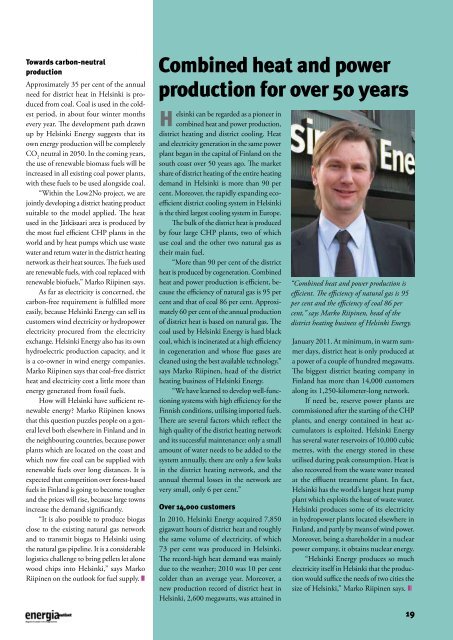Energia-uutiset
Create successful ePaper yourself
Turn your PDF publications into a flip-book with our unique Google optimized e-Paper software.
Towards carbon-neutral<br />
production<br />
Approximately 35 per cent of the annual<br />
need for district heat in Helsinki is produced<br />
from coal. Coal is used in the coldest<br />
period, in about four winter months<br />
every year. The development path drawn<br />
up by Helsinki Energy suggests that its<br />
own energy production will be completely<br />
CO 2<br />
neutral in 2050. In the coming years,<br />
the use of renewable biomass fuels will be<br />
increased in all existing coal power plants,<br />
with these fuels to be used alongside coal.<br />
“Within the Low2No project, we are<br />
jointly developing a district heating product<br />
suitable to the model applied. The heat<br />
used in the Jätkäsaari area is produced by<br />
the most fuel efficient CHP plants in the<br />
world and by heat pumps which use waste<br />
water and return water in the district heating<br />
network as their heat sources. The fuels used<br />
are renewable fuels, with coal replaced with<br />
renewable biofuels,” Marko Riipinen says.<br />
As far as electricity is concerned, the<br />
carbon-free requirement is fulfilled more<br />
easily, because Helsinki Energy can sell its<br />
customers wind electricity or hydropower<br />
electricity procured from the electricity<br />
exchange. Helsinki Energy also has its own<br />
hydroelectric production capacity, and it<br />
is a co-owner in wind energy companies.<br />
Marko Riipinen says that coal-free district<br />
heat and electricity cost a little more than<br />
energy generated from fossil fuels.<br />
How will Helsinki have sufficient renewable<br />
energy? Marko Riipinen knows<br />
that this question puzzles people on a general<br />
level both elsewhere in Finland and in<br />
the neighbouring countries, because power<br />
plants which are located on the coast and<br />
which now fire coal can be supplied with<br />
renewable fuels over long distances. It is<br />
expected that competition over forest-based<br />
fuels in Finland is going to become tougher<br />
and the prices will rise, because large towns<br />
increase the demand significantly.<br />
“It is also possible to produce biogas<br />
close to the existing natural gas network<br />
and to transmit biogas to Helsinki using<br />
the natural gas pipeline. It is a considerable<br />
logistics challenge to bring pellets let alone<br />
wood chips into Helsinki,” says Marko<br />
Riipinen on the outlook for fuel supply. zx<br />
Combined heat and power<br />
production for over 50 years<br />
H<br />
elsinki can be regarded as a pioneer in<br />
combined heat and power production,<br />
district heating and district cooling. Heat<br />
and electricity generation in the same power<br />
plant began in the capital of Finland on the<br />
south coast over 50 years ago. The market<br />
share of district heating of the entire heating<br />
demand in Helsinki is more than 90 per<br />
cent. Moreover, the rapidly expanding ecoefficient<br />
district cooling system in Helsinki<br />
is the third largest cooling system in Europe.<br />
The bulk of the district heat is produced<br />
by four large CHP plants, two of which<br />
use coal and the other two natural gas as<br />
their main fuel.<br />
“More than 90 per cent of the district<br />
heat is produced by cogeneration. Combined<br />
heat and power production is efficient, because<br />
the efficiency of natural gas is 95 per<br />
cent and that of coal 86 per cent. Approximately<br />
60 per cent of the annual production<br />
of district heat is based on natural gas. The<br />
coal used by Helsinki Energy is hard black<br />
coal, which is incinerated at a high efficiency<br />
in cogeneration and whose flue gases are<br />
cleaned using the best available technology,”<br />
says Marko Riipinen, head of the district<br />
heating business of Helsinki Energy.<br />
“We have learned to develop well-functioning<br />
systems with high efficiency for the<br />
Finnish conditions, utilising imported fuels.<br />
There are several factors which reflect the<br />
high quality of the district heating network<br />
and its successful maintenance: only a small<br />
amount of water needs to be added to the<br />
system annually, there are only a few leaks<br />
in the district heating network, and the<br />
annual thermal losses in the network are<br />
very small, only 6 per cent.”<br />
Over 14,000 customers<br />
In 2010, Helsinki Energy acquired 7,850<br />
gigawatt hours of district heat and roughly<br />
the same volume of electricity, of which<br />
73 per cent was produced in Helsinki.<br />
The record-high heat demand was mainly<br />
due to the weather; 2010 was 10 per cent<br />
colder than an average year. Moreover, a<br />
new production record of district heat in<br />
Helsinki, 2,600 megawatts, was attained in<br />
“Combined heat and power production is<br />
efficient. The efficiency of natural gas is 95<br />
per cent and the efficiency of coal 86 per<br />
cent,” says Marko Riipinen, head of the<br />
district heating business of Helsinki Energy.<br />
January 2011. At minimum, in warm summer<br />
days, district heat is only produced at<br />
a power of a couple of hundred megawatts.<br />
The biggest district heating company in<br />
Finland has more than 14,000 customers<br />
along its 1,250-kilometer-long network.<br />
If need be, reserve power plants are<br />
commissioned after the starting of the CHP<br />
plants, and energy contained in heat accumulators<br />
is exploited. Helsinki Energy<br />
has several water reservoirs of 10,000 cubic<br />
metres, with the energy stored in these<br />
utilised during peak consumption. Heat is<br />
also recovered from the waste water treated<br />
at the effluent treatment plant. In fact,<br />
Helsinki has the world’s largest heat pump<br />
plant which exploits the heat of waste water.<br />
Helsinki produces some of its electricity<br />
in hydropower plants located elsewhere in<br />
Finland, and partly by means of wind power.<br />
Moreover, being a shareholder in a nuclear<br />
power company, it obtains nuclear energy.<br />
“Helsinki Energy produces so much<br />
electricity itself in Helsinki that the production<br />
would suffice the needs of two cities the<br />
size of Helsinki,” Marko Riipinen says. zx<br />
19






